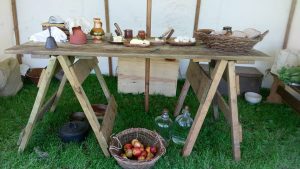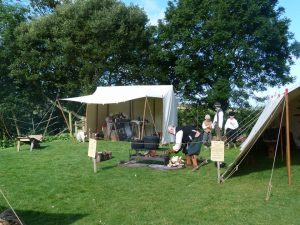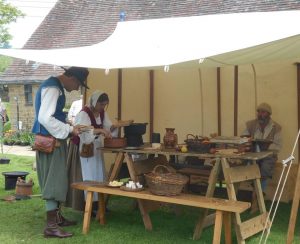The Wardour Garrison demonstrate open hearth cookery when ever they can, using period recipes where possible. Some ingredients are no longer easy to access, e.g. stock fish or salt cod, so modern ingredients maybe used.
 Cooking within the seventeenth century would have been carried out over open fires. The great houses contained large kitchens with massive fireplaces. Often these would also have contained bread ovens for baking bread.In the large households. There would have been a number of cooks, working to prepare and cook the food, often working under a master. Robert May was one such master who worked at Cowdray Castle where the Garrison demonstrated open hearth cookery, using his recipes (first published in 1660).
Cooking within the seventeenth century would have been carried out over open fires. The great houses contained large kitchens with massive fireplaces. Often these would also have contained bread ovens for baking bread.In the large households. There would have been a number of cooks, working to prepare and cook the food, often working under a master. Robert May was one such master who worked at Cowdray Castle where the Garrison demonstrated open hearth cookery, using his recipes (first published in 1660).
The food prepared would have varied greatly between the higher and lower social classes. The food of the wealthy would have contained spices and other costly imported ingredients, and with a greater variety of dishes. That of the lower classes would have simpler and often bland.
Food stuffs were also highly seasonal, effecting the amount and type of foods available at a given time of the year, thus food preservation was such as by smoking or drying . Butter was made and stored in wooden barrels packed with salt and had to be washed before use. The Garrison make butter for their own use but never need to store it!
Puddings – wrapped in linen cloths and boiled along side other foods in a cauldron -were a common way of cooking both sweet and savoury. “Dutch Pudding” – ground meat with bread crumbs and spices, wrapped in cabbage leaves – is a classic, often demonstrated by the Garrison as part of their mid-day meal.
In a garrison daily rations were cooked sometimes for families as well as the men . Soldiers sometimes messed in groups, which made serving simpler for the cooks. At a basic level bread, cheese and onions were considered adequate for marching rations. One main meal a day would have had to satisfy the ordinary soldier
